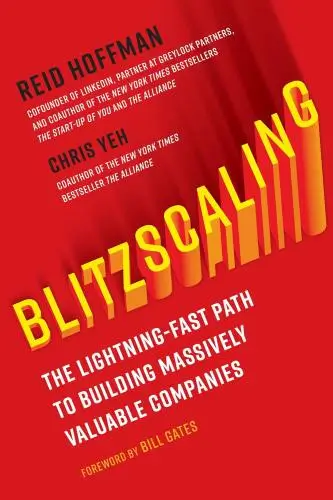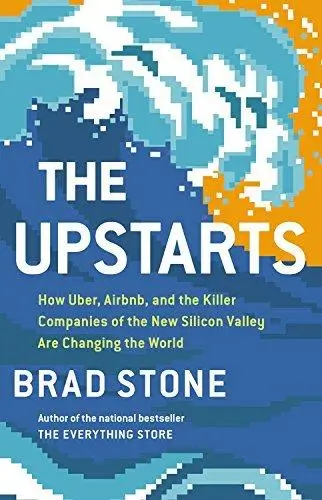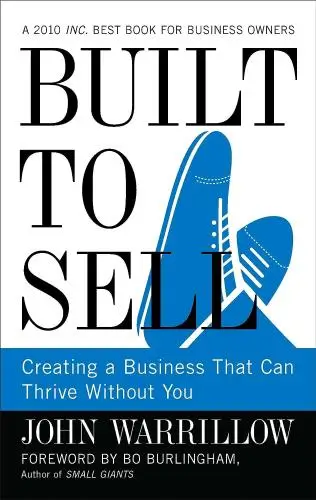
Blitzscaling
The Lightning-Fast Path to Building Massively Valuable Companies
What's it about?
Blitzscaling delves into the strategy of prioritizing speed over efficiency in the face of uncertainty. It unveils the secrets behind the explosive growth of Silicon Valley's most successful companies. Hoffman, a co-founder of LinkedIn, shares invaluable insights on scaling businesses rapidly to outpace competitors. The book is a treasure trove for entrepreneurs and leaders aiming for hypergrowth, offering practical advice on managing the challenges that come with scaling at lightning speed. A must-read for anyone looking to make their mark in today's fast-paced business world.
About the Author
Reid Hoffman is a tech entrepreneur, venture capitalist, and co-founder of LinkedIn. His book "Blitzscaling" explores the rapid growth strategies of successful startups. Hoffman's writing style is informative and engaging, offering valuable insights into the world of entrepreneurship and innovation. He is known for his unique perspectives on business strategies and leadership in the fast-paced tech industry.
10 Key Ideas of Blitzscaling
Embrace Uncertainty and Manage Risks Strategically
In the fast-paced world of scaling a business, uncertainty is a given.
The key to success lies in embracing this uncertainty rather than avoiding it.
This involves making strategic decisions with incomplete information and being prepared to pivot or adjust strategies as new information becomes available.
It's about balancing the risks and rewards, understanding that some risks are necessary for growth.
By prioritizing speed over efficiency in the short term, companies can capture market share and achieve a competitive advantage that outweighs the potential downsides of rapid expansion.
Learn DeeperStart with a flexible mindset: Accept that not all decisions will be made with complete information. Encourage yourself to be comfortable with making the best decision possible based on what you know at the time.
Implement a rapid feedback loop: Regularly collect and analyze feedback from your market, team, and product. Use this data to make informed adjustments to your strategy, product, or service quickly.
Prioritize learning over perfection: Focus on launching your ideas or products even if they're not perfect. The real-world feedback you'll receive is invaluable and will guide your next steps more effectively than speculation.
Develop a risk assessment framework: Identify potential risks associated with decisions and weigh them against the potential rewards. This will help you make more informed choices and understand which risks are worth taking.
Embrace failure as a learning tool: When things don't go as planned, dissect what happened and why. Use these insights to improve future decisions and strategies.
- Example
A tech startup rapidly develops a minimum viable product (MVP) and launches it to a select group of users. Based on user feedback, the company iterates on the product, making significant changes that better align with customer needs, leading to increased adoption and market share.
- Example
An e-commerce company decides to enter a new market with high uncertainty. Instead of fully committing all resources, they start with a pilot project to test the waters. The initial response is lukewarm, but the insights gained allow them to adjust their approach, eventually capturing a significant portion of the new market.
Prioritize Speed Over Efficiency in Critical Growth Phases
During critical growth phases, focusing on speed rather than efficiency can be the difference between leading the market and falling behind.
This approach involves investing resources aggressively to scale up operations, even if it means operating at a loss or with lower margins temporarily.
The rationale is that securing a dominant market position or achieving network effects can create long-term value that far exceeds the costs of inefficiency in the short term.
This tactic requires a careful balance, ensuring that the pursuit of speed does not compromise the product's quality or the company's long-term viability.
Learn DeeperEvaluate Your Market Position Regularly: Keep a close eye on your market position and the activities of your competitors. This will help you identify when entering a critical growth phase that might require blitzscaling.
Allocate Resources Strategically for Growth: During these critical phases, be prepared to reallocate resources aggressively towards growth initiatives. This might mean hiring more staff, increasing marketing spend, or investing in technology to scale up operations quickly.
Monitor Key Performance Indicators (KPIs) Closely: While prioritizing speed, it's essential to keep an eye on KPIs that indicate the health of your business. This ensures that while you're moving fast, you're not compromising on product quality or heading towards financial instability.
Be Prepared for Short-term Sacrifices: Understand and accept that blitzscaling may lead to short-term losses or inefficiencies. Prepare your team and stakeholders for this phase, emphasizing the long-term gains of securing a dominant market position.
Stay Flexible and Ready to Pivot: The market can change rapidly. Stay flexible in your strategies and be ready to pivot if the current approach isn't yielding the desired results. This agility can be crucial in maintaining momentum during rapid scaling.
- Example
A tech startup in the early stages of launching a new social media platform decides to blitzscale by aggressively investing in server capacity and marketing to quickly acquire users. Despite initial financial losses, they aim to establish a dominant market position and achieve network effects before competitors can catch up.
- Example
An e-commerce company entering a new market decides to prioritize speed over efficiency by offering significant discounts and investing heavily in logistics to ensure next-day deliveries. This strategy is aimed at quickly capturing market share, even though it initially operates at a loss.
Implement a Flexible Organizational Structure
As companies blitzscale, they must adapt their organizational structures to remain agile and responsive to changing market conditions.
This means creating a flexible organization where decision-making processes are decentralized, and teams have the autonomy to innovate and respond to challenges quickly.
A flat or modular organizational structure can facilitate communication and collaboration, enabling the company to innovate and scale more effectively.
This flexibility also helps in attracting and retaining talent who thrive in dynamic, fast-paced environments.
Learn DeeperEvaluate Your Current Organizational Structure: Take a close look at how your company is currently organized. Identify any bottlenecks in decision-making or areas where innovation is stifled due to hierarchical constraints.
Promote Autonomy Within Teams: Empower your teams by delegating decision-making authority. This encourages innovation and allows for quicker responses to market changes. Ensure each team understands their objectives and has the resources they need to achieve them.
Implement Modular Structures: Consider organizing your company into modules or teams that can operate semi-independently but are aligned with the overall company goals. This can improve collaboration and speed up project delivery.
Foster Open Communication: Create channels for open and transparent communication across all levels of the organization. This could be regular all-hands meetings, digital platforms for sharing ideas, or informal catch-ups.
Encourage a Culture of Flexibility and Adaptability: Make it clear that the company values flexibility and the ability to adapt to new situations. Recognize and reward behaviors that demonstrate these qualities.
- Example
Spotify's use of 'Squads' and 'Tribes' to maintain agility as it scales. Squads focus on specific features or products, allowing for specialized knowledge and faster development, while Tribes group related Squads to ensure alignment with the company's broader objectives.
- Example
Netflix's culture of 'Freedom and Responsibility' which empowers employees to make decisions based on the company's best interests without needing layers of approval. This approach supports rapid innovation and adaptation in the fast-paced entertainment industry.
Focus on Achieving Market Dominance Through Network Effects
Achieving market dominance often hinges on leveraging network effects, where the value of a product or service increases as more people use it.
Companies should focus on strategies that enhance these effects, such as creating viral growth mechanisms, reducing barriers to adoption, and incentivizing early users.
By doing so, they can create a self-reinforcing cycle of growth that makes it difficult for competitors to catch up.
This approach not only helps in capturing a significant market share but also in building a durable competitive advantage.
Learn DeeperIdentify and Enhance Your Network Effects: Start by pinpointing how your product or service becomes more valuable as more people use it. Then, brainstorm ways to amplify this effect. For instance, if you're developing a social app, consider features that encourage users to invite their friends.
Create Viral Growth Mechanisms: Implement features or incentives that naturally encourage users to share your product with others. This could be through referral bonuses, shared content, or collaborative features that require multiple users to participate.
Reduce Barriers to Adoption: Make it as easy as possible for new users to start using your service. This could mean simplifying the sign-up process, offering tutorials for new users, or providing initial incentives like discounts or free trials.
Incentivize Early Users: Reward early adopters to not only retain them but also turn them into advocates for your product. Early user incentives can range from exclusive access to new features, special pricing, or recognition within the community.
- Example
Dropbox's referral program is a classic example of creating viral growth mechanisms. By offering extra storage space for both the referrer and the referred, Dropbox significantly increased its user base.
- Example
LinkedIn's 'People You May Know' feature leverages network effects by making the platform more valuable as more professionals join and connect. It encourages users to keep expanding their network, thereby enhancing the value of LinkedIn for all users.
Invest Heavily in Top Talent During Early Stages
In the early stages of scaling, investing in top talent is crucial.
High-caliber employees bring innovative ideas, drive productivity, and can adapt to the rapid changes that come with blitzscaling.
This investment goes beyond just hiring; it includes creating an environment that attracts, retains, and motivates exceptional people.
Offering equity, fostering a culture of ownership, and providing opportunities for growth and development can make the company an attractive place for ambitious talent.
While costly, this strategy pays dividends by accelerating growth and innovation.
Learn DeeperIdentify the Key Roles That Will Drive Your Growth: Start by pinpointing the positions that are critical to your company's expansion. Think about areas where having top-notch talent can make a significant difference, such as product development, marketing, or sales.
Create a Compelling Value Proposition for Potential Employees: Beyond offering competitive salaries, think about what makes your company unique. This could include equity options, a strong company culture, opportunities for rapid career advancement, or the chance to work on cutting-edge projects.
Invest in Employee Development and Retention: Once you've attracted top talent, focus on keeping them engaged and motivated. Offer continuous learning opportunities, create clear paths for advancement, and foster a supportive, inclusive work environment.
Leverage Your Network for Talent Recommendations: Often, the best hires come from personal recommendations. Reach out to your professional network for suggestions on potential candidates who fit the high-caliber profile you're seeking.
- Example
A tech startup in its early stages might focus on hiring a visionary Chief Technology Officer (CTO) who can drive product innovation. They could offer a mix of competitive salary, significant equity, and the freedom to shape the company's technological direction to attract the right candidate.
- Example
A small but rapidly growing e-commerce company might identify customer experience as a key growth driver. They could invest in hiring and training a top-tier customer service team, offering them bonuses based on customer satisfaction scores and opportunities for career progression within the company.
Deeper knowledge. Personal growth. Unlocked.
Unlock this book's key ideas and 15M+ more. Learn with quick, impactful summaries.
Read Full SummarySign up and read for free!
Blitzscaling Summary: Common Questions
"Blitzscaling is prioritizing speed over efficiency in an environment of uncertainty." This quote from Reid Hoffman's book perfectly captures the essence of his exploration of how companies like Google and Facebook have achieved massive success by rapidly scaling their businesses despite the risks involved. The concept of blitzscaling, where prioritizing speed and growth can sometimes lead to chaos and turmoil, was both fascinating and thought-provoking for me.
Hoffman's in-depth analysis of the challenges and opportunities that come with blitzscaling, along with real-world examples and practical advice, kept me engaged throughout the book. Learning about the strategies and trade-offs involved in scaling a startup at such a rapid pace was eye-opening and left me with a deeper understanding of the dynamics at play in the tech industry. While at times the pace of the book mirrored the fast-paced nature of blitzscaling itself, the wealth of insights and lessons shared made it a highly valuable read.
Overall, Blitzscaling offers a fresh perspective on what it takes to build and grow a successful company in today's competitive landscape. I would highly recommend it to anyone interested in entrepreneurship, startups, or the tech industry.
Experience Personalized Book Summaries, Today!
Discover a new way to gain knowledge, and save time.
Sign up for our 7-day trial now.
No Credit Card Needed

Similar Books

$100M Offers
Alex Hormozi
Principles of Marketing, Global Edition
Gary Armstrong
The 100 Best Business Books of All Time
Jack Covert
Playing to Win
A.G. Lafley
Productize
Eisha Armstrong
Start Your Own Pet-Sitting Business and More
Entrepreneur Press
The 22 Immutable Laws of Marketing
Al Ries
The Upstarts
Brad Stone
Lean Analytics
Alistair Croll
Built to Sell
John WarrillowTrending Summaries

Peak
Anders Ericsson
Never Split the Difference
Chris Voss
Smart Brevity
Jim VandeHei
The Psychology of Money
Morgan Housel
The First 90 Days
Michael D. Watkins
Atomic Habits
James Clear
Thinking, Fast and Slow
Daniel Kahneman
The Body Keeps the Score
Bessel van der Kolk M.D.
The Power of Regret
Daniel H. Pink
The Compound Effect
Darren HardyNew Books

Job Interviews For Dummies®
Joyce Lain Kennedy
Job Interviews In A Week
Alison Straw
Handbook of Career Development
Gideon Arulmani
The Art of Spending Money
Morgan Housel
$100M Offers
Alex Hormozi
A Candle for Kiri
Edna Mae Holm
Principles of Marketing, Global Edition
Gary Armstrong
Serpent Rising: The Kundalini Compendium
Neven Paar
Feeling Is the Secret
Neville Goddard
